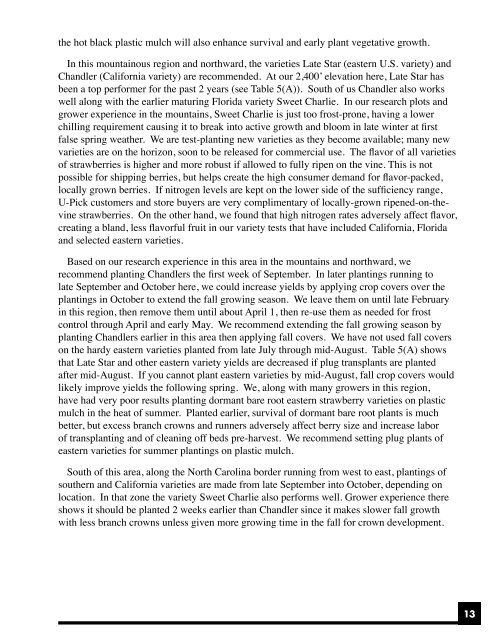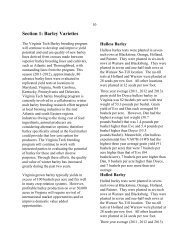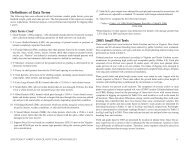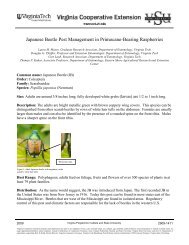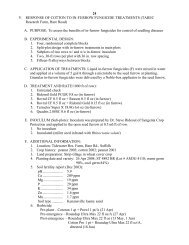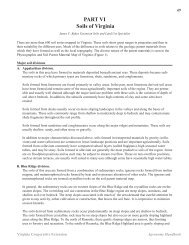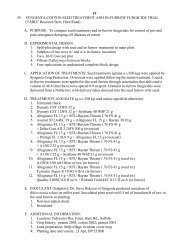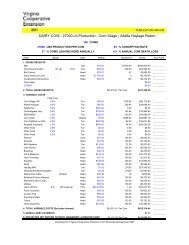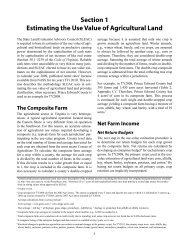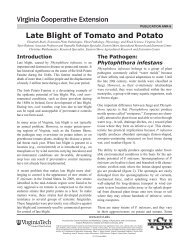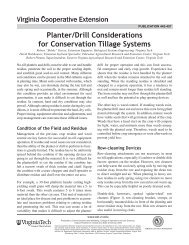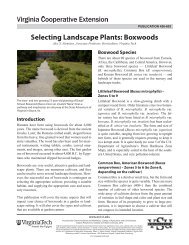PDF (1 MB) - Virginia Cooperative Extension - Virginia Tech
PDF (1 MB) - Virginia Cooperative Extension - Virginia Tech
PDF (1 MB) - Virginia Cooperative Extension - Virginia Tech
Create successful ePaper yourself
Turn your PDF publications into a flip-book with our unique Google optimized e-Paper software.
the hot black plastic mulch will also enhance survival and early plant vegetative growth.<br />
In this mountainous region and northward, the varieties Late Star (eastern U.S. variety) and<br />
Chandler (California variety) are recommended. At our 2,400’ elevation here, Late Star has<br />
been a top performer for the past 2 years (see Table 5(A)). South of us Chandler also works<br />
well along with the earlier maturing Florida variety Sweet Charlie. In our research plots and<br />
grower experience in the mountains, Sweet Charlie is just too frost-prone, having a lower<br />
chilling requirement causing it to break into active growth and bloom in late winter at first<br />
false spring weather. We are test-planting new varieties as they become available; many new<br />
varieties are on the horizon, soon to be released for commercial use. The flavor of all varieties<br />
of strawberries is higher and more robust if allowed to fully ripen on the vine. This is not<br />
possible for shipping berries, but helps create the high consumer demand for flavor-packed,<br />
locally grown berries. If nitrogen levels are kept on the lower side of the sufficiency range,<br />
U-Pick customers and store buyers are very complimentary of locally-grown ripened-on-thevine<br />
strawberries. On the other hand, we found that high nitrogen rates adversely affect flavor,<br />
creating a bland, less flavorful fruit in our variety tests that have included California, Florida<br />
and selected eastern varieties.<br />
Based on our research experience in this area in the mountains and northward, we<br />
recommend planting Chandlers the first week of September. In later plantings running to<br />
late September and October here, we could increase yields by applying crop covers over the<br />
plantings in October to extend the fall growing season. We leave them on until late February<br />
in this region, then remove them until about April 1, then re-use them as needed for frost<br />
control through April and early May. We recommend extending the fall growing season by<br />
planting Chandlers earlier in this area then applying fall covers. We have not used fall covers<br />
on the hardy eastern varieties planted from late July through mid-August. Table 5(A) shows<br />
that Late Star and other eastern variety yields are decreased if plug transplants are planted<br />
after mid-August. If you cannot plant eastern varieties by mid-August, fall crop covers would<br />
likely improve yields the following spring. We, along with many growers in this region,<br />
have had very poor results planting dormant bare root eastern strawberry varieties on plastic<br />
mulch in the heat of summer. Planted earlier, survival of dormant bare root plants is much<br />
better, but excess branch crowns and runners adversely affect berry size and increase labor<br />
of transplanting and of cleaning off beds pre-harvest. We recommend setting plug plants of<br />
eastern varieties for summer plantings on plastic mulch.<br />
South of this area, along the North Carolina border running from west to east, plantings of<br />
southern and California varieties are made from late September into October, depending on<br />
location. In that zone the variety Sweet Charlie also performs well. Grower experience there<br />
shows it should be planted 2 weeks earlier than Chandler since it makes slower fall growth<br />
with less branch crowns unless given more growing time in the fall for crown development.<br />
13


